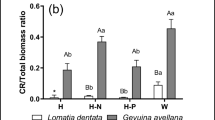Summary
Growth of the broad-leaved graminoid Milium effusum, occurring in shady deciduous forests, was matched with periods of high light influx through the tree canopy in spring and autumn. Fertile shoots grew faster than sterile shoots. Leaves on flowering shoots were fully developed when the budbreak started on the trees, whereas nonflowering shoots had fully developed leaves when the tree canopy closed. Leaf concentrations of N and P were high (6.1 and 0.74% respectively) in spring but decreased as the leaves expanded. Maximum pool sizes of N and P in whole tillers were reached about one month after the onset of spring growth, whereas maximum spring pools of K, Mg, and Ca were timed with peak biomass about one month later. The leaves lost nutrients during summer when no growth took place. Since leaching losses were negligible, nutrients were probably allocated from the leaves to support root growth. Autumn reallocation to winter stores was low. The pattern of growth and nutrient use suggests that light availability, i.e., the resource in relatively lowest supply, regulates the investment of the resource in highest supply, i.e., nutrients. This is consistent with previously reported observations on Eriophorum vaginatum, a graminoid of low nutrient — high light environments. This species utilizes nutrients efficiently at the expense of less efficient acquisition of carbon. We suggest that selection for efficient utilization of the resource in lowest relative supply has been a strong driving force behind the physiological adaptation of both species to their environments.
Similar content being viewed by others
References
Bloom AJ, Chapin, FS III, Mooney HA (1985) Resource limitation in plants — an economic analogy. Annu Rev Ecol Syst 16:363–392
Chapin FS III (1980) The mineral nutrition of wild plants. Annu Rev Ecol Syst 11:233–260
Chapin FS III, Bloom AJ, Field CB, Waring RH (1987) Plant responses to multiple environmental factors. BioScience 37:49–56
Field C, Mooney HA (1986) The photosynthesis-nitrogen relationship in wild plants. In: Givnish TJ (ed) On the economy of plant form and function. Cambrdige Univ Press, Cambridge, pp 25–55
Givnish TJ (1987) Comparative studies of leaf form: Assessing the relative rates of selective pressure and phylogenetic constraints. New Phytol 106 (Suppl):131–160
Grime JP (1977) Evidence for the existence of three primary strategies in plants and its relevance to ecological and evolutionary theory. Am Nat 111:1169–1194
Johnson DA, Tieszen LL (1976) Aboveground biomass allocation, leaf growth, and photosynthesis patterns in tundra plant forms in arctic Alaska. Oecologia (Berl) 24:159–173
Jonasson S, Chapin FS III (1985) Significance of sequential leaf development for nutrient balance of the cotton sedge Eriophorum vaginatum L. Oecologia (Berl) 67:511–518
Kedrowski RA (1983) Extraction and analysis of nitrogen, phosphorus and carbon fractions in plant material. J Plant Nutr 6:989–1011
Robertson KP, Woolhouse HW (1984) Studies of the seasonal cource of carbon uptake of Eriophorum vaginatum in a moorland habitat II. The seasonal cource of photosynthesis. J Ecol 72:685–700
Schulze E-D (1982) Plant life forms as related to plant carbon, water and nutrient relations. Encycl Plant Physiol, vol 12B. Springer, Berlin Heidelberg New York, pp 615–676
Sjörs H (1967) Nordisk växtgeografi (2 ed). Scandinavian Univ Books. Köpenhamn Oslo Stockholm
Verdouw H, van Echteld CJA, Dekkers EMJ (1978) Ammonia determination based on indophenol formation with sodium salicylate. Water Res 12:399–402
Author information
Authors and Affiliations
Rights and permissions
About this article
Cite this article
Jonasson, S., Widerberg, B. The resource balance of Milium effusum with emphasis on environmental resource supply. Oecologia 76, 11–19 (1988). https://doi.org/10.1007/BF00379594
Received:
Issue Date:
DOI: https://doi.org/10.1007/BF00379594




